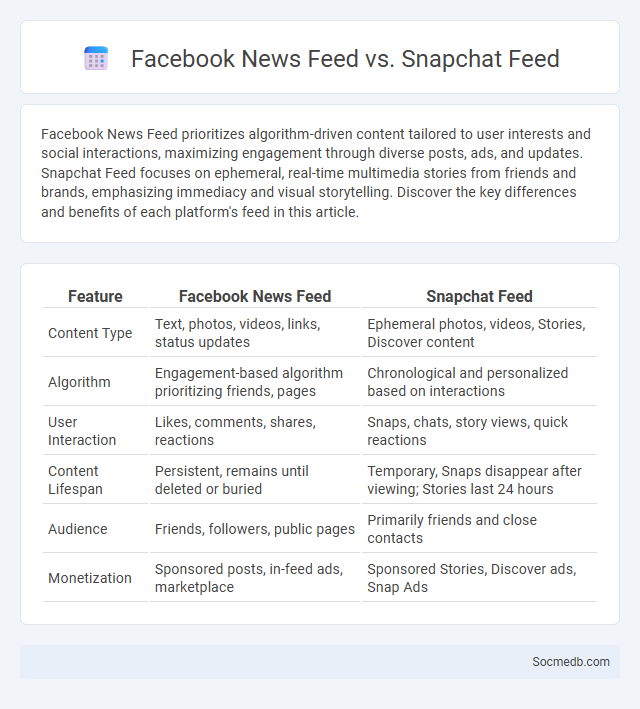
Photo illustration: Facebook News Feed vs Snapchat Feed
Facebook News Feed prioritizes algorithm-driven content tailored to user interests and social interactions, maximizing engagement through diverse posts, ads, and updates. Snapchat Feed focuses on ephemeral, real-time multimedia stories from friends and brands, emphasizing immediacy and visual storytelling. Discover the key differences and benefits of each platform's feed in this article.
Table of Comparison
| Feature | Facebook News Feed | Snapchat Feed |
|---|---|---|
| Content Type | Text, photos, videos, links, status updates | Ephemeral photos, videos, Stories, Discover content |
| Algorithm | Engagement-based algorithm prioritizing friends, pages | Chronological and personalized based on interactions |
| User Interaction | Likes, comments, shares, reactions | Snaps, chats, story views, quick reactions |
| Content Lifespan | Persistent, remains until deleted or buried | Temporary, Snaps disappear after viewing; Stories last 24 hours |
| Audience | Friends, followers, public pages | Primarily friends and close contacts |
| Monetization | Sponsored posts, in-feed ads, marketplace | Sponsored Stories, Discover ads, Snap Ads |
Introduction to News Feeds: Facebook vs Snapchat vs Generic News Feed
Facebook's news feed prioritizes algorithm-driven content tailored to your interactions, showing posts from friends, pages, and groups to maximize engagement. Snapchat's feed emphasizes ephemeral, real-time Stories and Discover content from friends and publishers, enhancing immediacy and visual storytelling. Generic news feeds typically aggregate a mix of personalized updates, trending topics, and sponsored content but lack the specialized features that define Facebook and Snapchat's platforms.
Understanding the Purpose of Each News Feed
Each social media platform curates its news feed to align with specific user goals, such as Facebook prioritizing personal connections and event updates, while LinkedIn focuses on professional networking and industry news. Understanding these distinct purposes helps users navigate content effectively, ensuring engagement with relevant posts and minimizing information overload. Tailoring content to platform-specific algorithms optimizes visibility and interaction within target audiences.
User Interface and Feed Navigation Compared
Social media platforms prioritize intuitive user interfaces to enhance your interaction and engagement, focusing on streamlined navigation that allows quick access to content and features. Feed navigation varies across platforms; infinite scrolling dominates for continuous content consumption, while algorithm-driven feeds tailor posts to user preferences, increasing relevance. Clear icons, responsive touch controls, and concise layouts improve usability, encouraging longer sessions and seamless content discovery.
Algorithmic Personalization and Content Delivery
Algorithmic personalization on social media platforms uses machine learning models to analyze user interactions, preferences, and behavior patterns, tailoring content feeds to individual interests. This targeted content delivery increases user engagement by prioritizing posts, advertisements, and recommendations that align with predicted user preferences. Continuous optimization of these algorithms enhances relevance, driving higher retention rates and maximizing platform monetization opportunities.
Visual vs Textual Content Emphasis
Visual content on social media, such as images and videos, captures attention faster and boosts engagement rates by up to 80% compared to textual posts. Textual content provides depth and context, allowing you to convey detailed information and storytelling that visual content alone may lack. Balancing your social media strategy with a mix of compelling visuals and well-crafted text enhances audience connection and drives higher interaction levels.
User Engagement and Interaction Patterns
User engagement on social media platforms is driven by interactive features such as likes, comments, shares, and live streaming, which foster real-time communication and community building. Interaction patterns reveal that content with emotional appeal, visual elements, and personalized relevance significantly increases user participation and time spent on platforms. Data analytics tools track engagement metrics to optimize content strategies, enhancing user retention and platform growth.
Discoverability and Content Distribution
Improving discoverability on social media involves optimizing profile keywords, utilizing relevant hashtags, and engaging with trending topics to increase visibility. Effective content distribution requires leveraging multiple platforms, scheduling posts for peak user activity, and using analytics to tailor content strategies. Consistent interaction with followers and timely sharing of diverse media formats enhance reach and user engagement.
Privacy and Data Handling in News Feeds
Social media platforms implement advanced privacy controls to manage how user data is collected, stored, and displayed in news feeds, ensuring personalized content while protecting sensitive information. Algorithms prioritize relevant posts based on user interactions, but strict data handling policies regulate third-party access to prevent unauthorized use. Transparency reports and privacy settings empower users to customize their news feed experience, balancing engagement with data security.
Impact on User Attention and Information Consumption
Social media platforms significantly influence user attention by promoting rapid content consumption and constant notifications that fragment focus. Your information intake often becomes shaped by algorithms prioritizing engagement over accuracy, leading to echo chambers and selective exposure. This dynamic affects how users process news, reducing deep comprehension and increasing susceptibility to misinformation.
Which News Feed is Best for Different User Needs?
Facebook News Feed offers personalized updates and community engagement, making it ideal for users seeking a blend of social interaction and news. Twitter's real-time feed suits those who prioritize instant updates and trending topics across diverse interests. Instagram's visually-driven feed caters to users focused on lifestyle, creativity, and influencer content.
 socmedb.com
socmedb.com